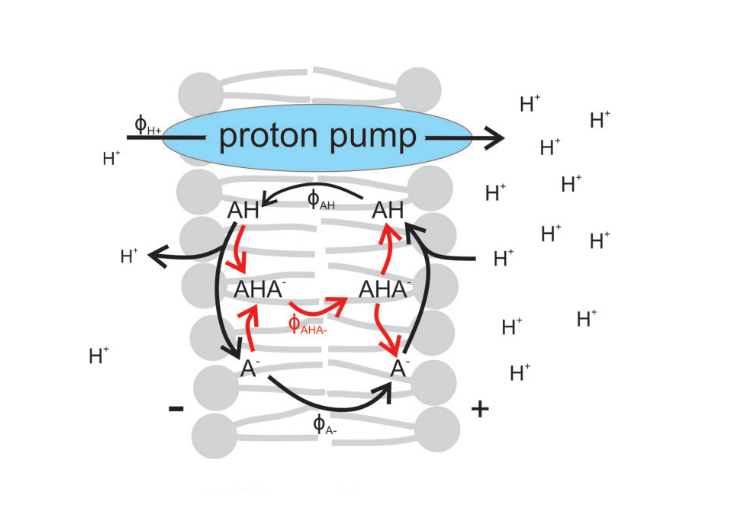Predicting protonophoric uncoupling toxicity from molecular structure
In mitochondria, energy stored in a proton- and electrical gradient across the inner mitochondrial membrane drives ATP-synthesis. ATP-synthesis is thus coupled to the electron transport chain that transfers protons across the membrane to sustain this gradient. A protonophoric uncoupler is a compound that can carry protons across the membrane. It traverses the membrane in its charged form, picks up a proton and traverses back across the membrane, thereby shuttling a proton from one side to the other.
 Modeling uncoupling toxicity
Modeling uncoupling toxicity
The process is driven by an electric and chemical gradient, and will dissipate the stored energy into heat instead of ATP, as long as a gradient exists. The potency of the uncoupler will depend on different factors, most importantly on the membrane permeability of the anionic species, but also on the permeability of the neutral species, or the pH- and electrical gradient. Furthermore, the anionic and neutral monomer can combine to form a heterodimeric species that might dominate anionic permeation. Using our gathered knowledge on membrane permeability and quantum chemical calculations to predict the formation and permeation of the heterodimer, we predicted this toxic effect of uncoupling with a mechanistic model, overcoming the limitations of previous models that neither considered neutral permeability nor the specific pH- and electrical gradients (Ebert and Goss 2020). In an extensive screening of 6000 anionic compounds the model demonstrated higher sensitivity and comparable specificity to existing structural alert profilers, making it a valuable tool for accurate screening of protonophoric uncoupling in drug development and toxicity assessment (Ebert and Goss 2022).
Related own publications:
Ebert, Andrea, and Kai Uwe Goss. 2020. “Predicting Uncoupling Toxicity of Organic Acids Based on Their Molecular Structure Using a Biophysical Model.” Chemical Research in Toxicology 33 (7): 1835–44.
https://doi.org/10.1021/acs.chemrestox.0c00063
Ebert, Andrea, and Kai Uwe Goss. 2022. “Screening of 6000 Compounds for Uncoupling Activity: A Comparison Between a Mechanistic Biophysical Model and the Structural Alert Profiler Mitotox.” Toxicological Sciences 185 (2): 208–19.
https://doi.org/10.1093/toxsci/kfab139
